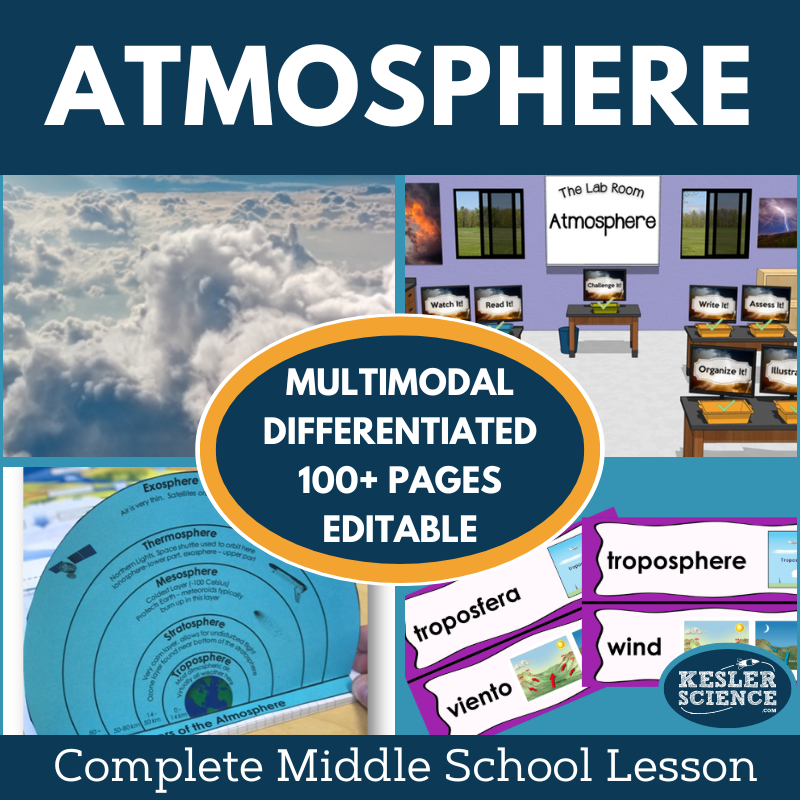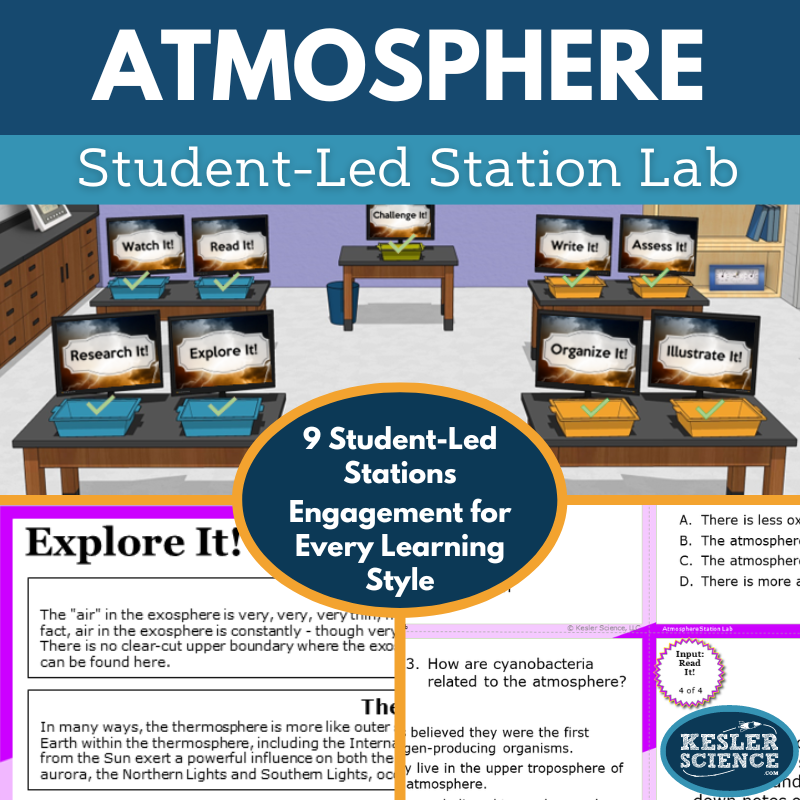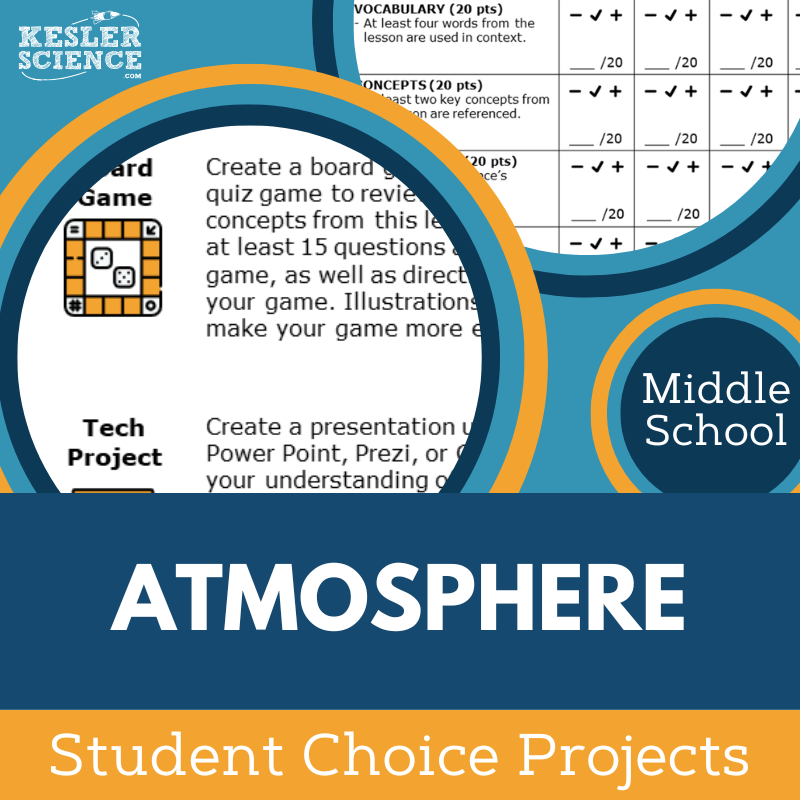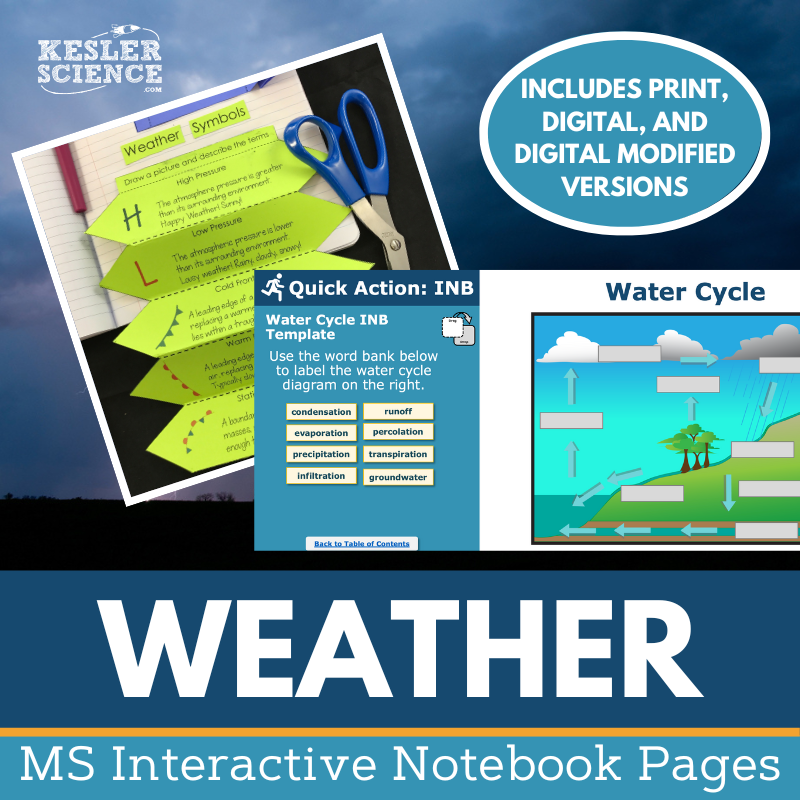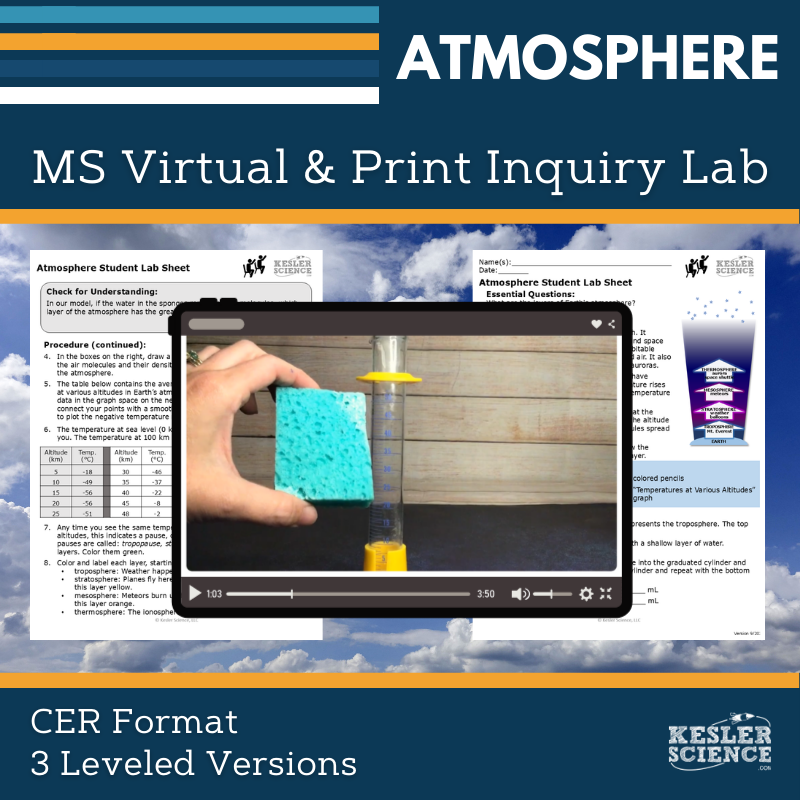Atmosphere Activities for Middle School Science
The Kesler Science Atmosphere Complete 5E Lesson is a comprehensive, student-centered unit that guides middle school learners through every phase of the 5E model. The resources below will give students a comprehensive understanding of the atmosphere. All of the following materials are also included in the Kesler Science Membership.
The Kesler Science Atmosphere Complete 5E Lesson offers a thorough and engaging unit that covers each phase of the 5E model. The lesson includes an Atmosphere Station Lab for the Exploration phase, allowing students to engage in hands-on activities as they explore the layers of Earth's atmosphere, cloud types, and the composition of the air. For the Explanation phase, the lesson features an interactive PowerPoint with digital Interactive Notebook (INB) templates, providing students with a detailed and visual understanding of atmospheric concepts.
In addition to the core activities, the lesson provides materials for the Engagement phase, sparking students' curiosity with thought-provoking questions and introductory activities. The Elaboration phase includes student-choice project ideas, enabling learners to explore atmospheric concepts in more depth through creative and personalized assignments. These projects foster student-led exploration and deeper engagement with the content.
For Evaluation, the lesson includes assessments to gauge student understanding and mastery of key atmospheric concepts. By the end of the lesson, students will be able to compare and contrast the different layers of Earth's atmosphere, identify the composition of the atmosphere, and recognize cloud types within the troposphere, demonstrating a comprehensive understanding of the topic.
The Kesler Science Atmosphere Complete 5E Lesson offers a thorough and engaging unit that covers each phase of the 5E model. The lesson includes an Atmosphere Station Lab for the Exploration phase, allowing students to engage in hands-on activities as they explore the layers of Earth's atmosphere, cloud types, and the composition of the air. For the Explanation phase, the lesson features an interactive PowerPoint with digital Interactive Notebook (INB) templates, providing students with a detailed and visual understanding of atmospheric concepts.
In addition to the core activities, the lesson provides materials for the Engagement phase, sparking students' curiosity with thought-provoking questions and introductory activities. The Elaboration phase includes student-choice project ideas, enabling learners to explore atmospheric concepts in more depth through creative and personalized assignments. These projects foster student-led exploration and deeper engagement with the content.
For Evaluation, the lesson includes assessments to gauge student understanding and mastery of key atmospheric concepts. By the end of the lesson, students will be able to compare and contrast the different layers of Earth's atmosphere, identify the composition of the atmosphere, and recognize cloud types within the troposphere, demonstrating a comprehensive understanding of the topic.
The Kesler Science Atmosphere Station Lab offers a student-led, modular learning experience for middle schoolers, allowing them to explore the atmosphere through eight differentiated stations and a bonus challenge station for early finishers. With minimal teacher facilitation, students work independently or in small groups, gaining a deeper understanding of how air masses interact to cause weather changes.
The nine stations include a variety of input and output activities. Input stations like "Explore It!" and "Watch It!" engage students with hands-on demonstrations, research, and videos. Output stations such as "Illustrate It!" and "Write It!" allow students to creatively show what they've learned through drawing, writing, and problem-solving activities.
These station labs are fully equipped with signage, literature, and task cards to guide students through the activities. They can be used in-person or virtually, with digital versions available for tasks like manipulating images in PowerPoint or Google Slides. This flexible, student-centered approach makes learning about the atmosphere engaging and effective for all learners.
The Kesler Science Atmosphere Station Lab offers a student-led, modular learning experience for middle schoolers, allowing them to explore the atmosphere through eight differentiated stations and a bonus challenge station for early finishers. With minimal teacher facilitation, students work independently or in small groups, gaining a deeper understanding of how air masses interact to cause weather changes.
The nine stations include a variety of input and output activities. Input stations like "Explore It!" and "Watch It!" engage students with hands-on demonstrations, research, and videos. Output stations such as "Illustrate It!" and "Write It!" allow students to creatively show what they've learned through drawing, writing, and problem-solving activities.
These station labs are fully equipped with signage, literature, and task cards to guide students through the activities. They can be used in-person or virtually, with digital versions available for tasks like manipulating images in PowerPoint or Google Slides. This flexible, student-centered approach makes learning about the atmosphere engaging and effective for all learners.
The Kesler Science Atmosphere Student Choice Projects allow middle school students to select from multiple project options that suit their personal learning styles. With six different project choices and a “design your own” option, students are encouraged to take control of their learning. A grading rubric is provided, and teachers can modify it to meet their assessment needs.
These flexible, multimodal projects allow students to demonstrate their understanding of atmospheric concepts creatively, whether through presentations, models, or digital media. The project options cater to various learning needs, with differentiated tasks for students requiring additional support and challenging activities for advanced learners.
Included in the lesson are a choice board with nine project options, teacher directions, and editable rubric pages to assess key criteria such as vocabulary, clarity, and accuracy. Most projects require basic classroom supplies, such as paper and markers, and many can be completed digitally, making them easy to integrate into both in-person and remote learning environments.
The Kesler Science Atmosphere Student Choice Projects allow middle school students to select from multiple project options that suit their personal learning styles. With six different project choices and a “design your own” option, students are encouraged to take control of their learning. A grading rubric is provided, and teachers can modify it to meet their assessment needs.
These flexible, multimodal projects allow students to demonstrate their understanding of atmospheric concepts creatively, whether through presentations, models, or digital media. The project options cater to various learning needs, with differentiated tasks for students requiring additional support and challenging activities for advanced learners.
Included in the lesson are a choice board with nine project options, teacher directions, and editable rubric pages to assess key criteria such as vocabulary, clarity, and accuracy. Most projects require basic classroom supplies, such as paper and markers, and many can be completed digitally, making them easy to integrate into both in-person and remote learning environments.
The Kesler Science Weather Interactive Notebook Bundle offers both print and digital versions to enhance student engagement while teaching key weather concepts. Perfect for traditional classrooms, 1:1 settings, or distance learning, this bundle covers important topics such as the atmosphere, catastrophic events, convection currents, hurricane formation, the water cycle, and weather maps.
Digital versions include a customizable PowerPoint file that can be uploaded to Google Slides or integrated into platforms like MS Teams, Schoology, and Canvas. It also features reflection pages, spaces for student notes, and a modified version for students with accommodations, all supported by a teacher answer key.
The paper version includes complete blank templates for the interactive notebook, pre-filled versions for students needing modifications or those who missed class, and color photos that demonstrate how each template is used, making it a versatile tool for teachers and students alike.
The Kesler Science Weather Interactive Notebook Bundle offers both print and digital versions to enhance student engagement while teaching key weather concepts. Perfect for traditional classrooms, 1:1 settings, or distance learning, this bundle covers important topics such as the atmosphere, catastrophic events, convection currents, hurricane formation, the water cycle, and weather maps.
Digital versions include a customizable PowerPoint file that can be uploaded to Google Slides or integrated into platforms like MS Teams, Schoology, and Canvas. It also features reflection pages, spaces for student notes, and a modified version for students with accommodations, all supported by a teacher answer key.
The paper version includes complete blank templates for the interactive notebook, pre-filled versions for students needing modifications or those who missed class, and color photos that demonstrate how each template is used, making it a versatile tool for teachers and students alike.
The Atmosphere Inquiry Lab gives students the opportunity to explore how the atmosphere changes with altitude through both digital and hands-on formats. In this lab, students will investigate temperature changes and air molecule density across different atmospheric layers, labeling each layer and its boundaries. Both versions include comprehension checks, C.E.R. prompts, and reflection questions to help students process their learning.
Three differentiated levels—dependent, modified, and independent—support a wide range of learners. The dependent version guides students with procedures and questions, the modified version offers the most structure with scaffolds like sentence stems, and the independent version encourages student-led inquiry. Teachers can choose the level that best suits their class and adjust as needed using editable files.
Hands-on activities use simple materials like colored sponges, water, and colored pencils, while the digital version requires no materials and is ideal for remote learning or absent students. The lab is fully customizable, compatible with Google Slides, and includes teacher resource pages, answer keys, and editable files for maximum flexibility.
The Atmosphere Inquiry Lab gives students the opportunity to explore how the atmosphere changes with altitude through both digital and hands-on formats. In this lab, students will investigate temperature changes and air molecule density across different atmospheric layers, labeling each layer and its boundaries. Both versions include comprehension checks, C.E.R. prompts, and reflection questions to help students process their learning.
Three differentiated levels—dependent, modified, and independent—support a wide range of learners. The dependent version guides students with procedures and questions, the modified version offers the most structure with scaffolds like sentence stems, and the independent version encourages student-led inquiry. Teachers can choose the level that best suits their class and adjust as needed using editable files.
Hands-on activities use simple materials like colored sponges, water, and colored pencils, while the digital version requires no materials and is ideal for remote learning or absent students. The lab is fully customizable, compatible with Google Slides, and includes teacher resource pages, answer keys, and editable files for maximum flexibility.
Year-Round Resources
These year-round activities will increase your students' understanding of many middle school science topics. All of these activities are also included in the Kesler Science Membership.
Visual Data & Graphing
You're not alone if your students struggle with understanding graphs, charts, and tables. It's a skill that takes an enormous amount of practice. This resource will help students build a strong foundation in analyzing data and creating their own data visualizations.
Bell Ringers and Warm-Ups
These middle school science bell ringers are an excellent way to engage your students as soon as they walk into your classroom. This comprehensive FULL YEAR resource includes everything you need to start off each science class with an interesting warm-up activity.
Review Board Games
Each game board has been carefully designed to keep students engaged. There are 10 different action spaces on each board and dozens of question cards. All of the actions are related to science concepts and keep the students motivated throughout the game.
Each game is ready to play. Simply print out the board and the cards and let the students enjoy reviewing nine different units.
Essential Questions
Below are the essential questions associated with the lessons and activities included in this unit. This topic is only one of more than 100 middle school science topics included in the Kesler Science Membership.
-
What is the composition of the Earth’s atmosphere?
-
What are the layers of the Earth’s atmosphere?
Kesler Science Membership
Imagine never having to search for another middle school science lesson again. The membership gives you access to ALL of the Kesler Science products in one place (Yes, including everything above).
Say goodbye to long hours of lesson prep.

